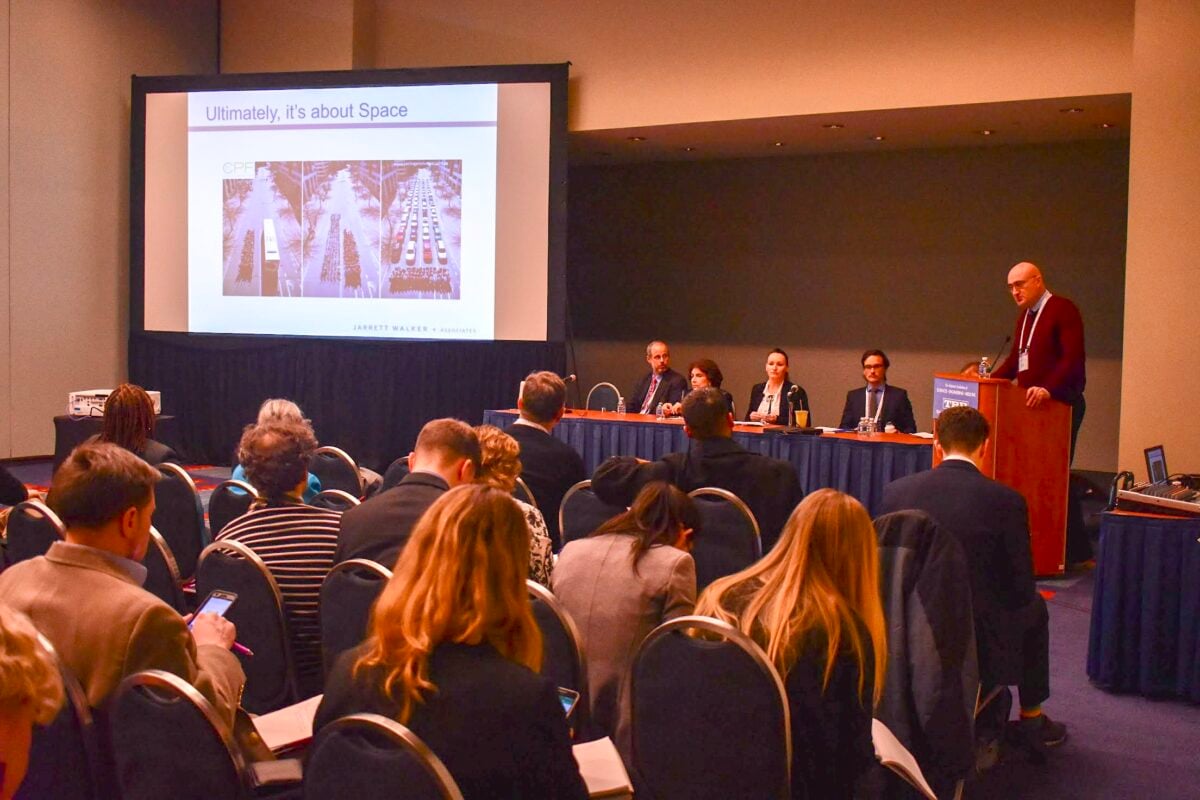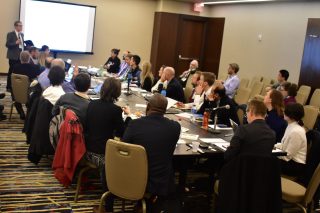
(Photos: Aaron Brown)
As we shared yesterday, BikePortland correspondent Aaron Brown is at the Transportation Research Board Annual Meeting in Washington D.C. thanks to a funding partnership with the Transportation Research and Education Center at Portland State University. Here’s his first dispatch…
Jarrett Walker: Geometry of the City
“When we get excited about [a new form of transportation] that won’t scale, we’re basically getting excited about something that will only be for the rich.”
— Jarrett Walker at TRB
Considering his international profile and impressive career consulting for cities across the planet, Jarrett Walker keeps a relatively low profile in Portland. You may have read his book, Human Transit, or you might have heard his name come up a few times after Elon Musk called him an “idiot” on Twitter (which, in my book, is the most rarefied of compliments).
Walker’s presentation, titled “The Geometry of the City,” spoke to how to best match the efficacies of public transportation with the need to provide service to address unmet needs in underserved communities.
With characteristic simplicity and clarity, Walker explained the basic ingredients that make transit function most effectively – having dense, walkable destinations all located along a linear line that can be served with frequent, reliable service. The spatial dynamics of this sort of transit-oriented community allow for a community to continue to grow while only adding marginal additional costs in mobility. Auto-centric growth on the other hand, is enormously space-intensive (just look at how much urban space is taken up by freeways and parking lots) and therefore “scales” poorly. This will be true, Walker points out, of any auto-centric transportation system, whether the vehicles run on gas or electricity, and whether they’re driven by humans, source code, or robots.
Advertisement
While other presentations in the panel were focused on specific tricks to make TNCs (transportation network companies like Uber and Lyft) and other mobility services more available to low-income individuals, Walker instead advocated for building as many effective, dense, transit-connected communities so that transit would be available to a larger number of people.
From Walker’s perspective, the best way to ensure that public transit can service low-income communities is to to build a transit system (and corresponding land-use plan) that makes transit as efficient as possible – doing so means that it’ll only be easier to “scale-up.” “Only an idea that scales is an idea that can be delivered to everyone,” Walker concludes. “When we get excited about [a new form of transportation] that won’t scale, we’re basically getting excited about something that will only be for the rich… We owe it to our children to try to not build unjust landscapes anymore.”
Climate Change
Norway is on pace to reduce transportation-related carbon emissions to 50% of their 2005 levels by 2030, and has done so by pricing carbon and massive investments in transit and biking in urban cores…
Perhaps I’m just paranoid, but I spend a lot of time thinking about how the Intergovernmental Panel on Climate Change (IPCC) recently put out a report saying that our society has 11 years to fundamentally decarbonize to stave off horrific, destructive climate change. It’s mind-boggling to process the degree to which our planet might be inhospitable for basic human life in as little as a decade, and even more so to ask how institutions are evolving to prevent this from happening or mitigate the most negative of consequences.
With that warm thought looming in my head, I attended the “Decarbonizing Transportation: Current Efforts and Ongoing Needs (for the #1 Source of GHG Emissions in the US)” session. While the presentation from the American speakers in Rhode Island and Columbus were heartening, it was depressing to compare them to the presenter from Norway.
Norway is on pace to reduce transportation-related carbon emissions to 50% of their 2005 levels by 2030, and has done so by pricing carbon, massive investments in transit and biking in urban cores, and moving quickly to electrify the existing automobile fleet. Oregon isn’t doing any of that.
President Trump’s Transportation Secretary Elaine Chao spoke at the conference, and while I didn’t see her presentation, it sounds as though she didn’t mention climate change once. Instead, she spoke about the bright new future in drone delivery service. Yikes!
Bicycle Transportation Committee

There are so many glitzy presentations, gimmicky PR stunts (I saw a bizarre-looking autonomous vehicle driving around), and hob-nobbing receptions throughout the conference that it’s easy to forgot the logistical work underway at the literally hundreds of committees and subcommittees that meet at TRB. These committees are where a lot of the “work” of TRB takes place — academics discuss trends in scholarship, prioritize topics that need to be funded for further research and inquiry in the future, and help set agendas that indirectly, yet inevitably, guide where research funding goes.
On the recommendation of Dr. Tara Goddard (a former Portlander and Portland State University alum), I sat in on the second half of the Standing Committee on Bicycle Transportation to round out my Monday afternoon. Dr. Goddard sits on the committee and noted that the amount of research on bicycle transportation has grown exponentially in recent years — scholars are now studying everything from the width of bike boxes, a racial equity lens to bike infrastructure planning, and cycling’s impacts on public health.
As scholars push the boundaries o scholarship to undertake increasingly intersectional studies of transportation and climate change, affordable housing, public health, and equity, these committees are the spaces where this work will be greenlit, funded, and promoted.
Of little surprise, then, to see the Portland Bureau of Transportation’s very own Peter Koonce (head of the agency’s Signals, Streetlights and Intelligent Transportation Services (ITS) division) swing by the hearing. Koonce gave an overview of the National Association of City Transportation Officials (NACTO) ongoing research and how it relates to the Bicycle Transportation Committee.
Stay tuned for more from TRB. Follow me on Twitter for more updates.
— Aaron Brown, @ambrown on Twitter
Special thanks to TREC at PSU for making this coverage possible.
Views expressed by the author are his own and do not reflect those of TREC at PSU.
Never miss a story. Sign-up for the daily BP Headlines email.
BikePortland needs your support.

